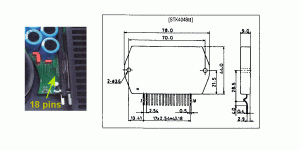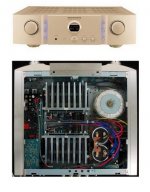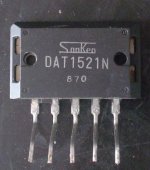


I don't think so (at least not the one in the link) , that is a 4050 .. (see attachment) .. even if it did , no 290w into 4r .. B$.Densen use 2SC2922 and 2SA1216
GK is right.... strip caps - use toriod , put 2 decent DIY amps in there instead. I can't believe they try to pass this off as Hi-fi !!
OS
Attachments
Kurt von Kubik,
I comprehend, however I say the opposite of that.
I understand, but you actually first have to define good and bad meaurements.
To me the lowest THD+N is not the best, I like it more when THD+N are reasonable but completely linear, just depending on voltage as the ideal amplifier.
If it is 0,1%THD or 0,0000001% I don´t care, but I do care if it is 0,1% @ 1KHz and 1,5% @10KHz. And in addition I do seldom like amps linearised by NFB.
But large amounts of THD+N, narrow bandwith and failure to deliver large currents, are always bad, and sounds bad, as they also are indicators of design flaws.

I don't think so (at least not the one in the link) , that is a 4050 .. (see attachment) .. even if it did , no 290w into 4r .. B$.
GK is right.... strip caps - use toriod , put 2 decent DIY amps in there instead. I can't believe they try to pass this off as Hi-fi !!
OS
It is right, they do feature Sanken 2SC2922 and complementary in practically all their amps.
And you are right, 2SC2922 and compl. are rated for 150 Watts and no more. Bringing them to deliver 250 Watts will imediatly cause dammage, as this is beyound 2.nd breakdown point, according to datasheets.
@ 50V 2.nd breakdown is around 4A based on a junction temp @ 150 dgr. C.
It seems as if Densen incorporates the crest factor in their design and in their data statements, which normally actually should be "payed for headroom" in favour of the consumer.
Last edited:
Claimed 294 watts into 4ohms from a single IC with those smallish heatsinks seams to be alot for a typical AB/B amplifier. I can not read the language the article is written in though, just see the specs they give. Maybe they have a fancy trick or it has switching rails or something. Still big claims for a single IC.
If you think the heatsinks are to small on the B350 Mono amplifier, then you should have a look at this: Densen Audio Technologies
This a stereo amplifier rated @ the same output power as the monoamp, featuring the same heatsinks
Maybe the scientific calculator ran out of batteries @ Densen.
And I don´t know if this is common knowledge, but heatsinks should be black, or they will loose their ability to disperse heatrays.
Last edited:
[And I don´t know if this is common knowledge, but heatsinks should be black, or they will loose their ability to disperse heatrays.
Marantz knows nothing!!![/QUOTE]
That might not be the case.
Heatsinks ought to be black to be as effective as possible.
If you choose to use bare aluminium for heatsinks, you´ll have to use larger heatsinks, than if you used black ones. Actually around 20% larger.
If you do so, there will be no problem.
So Marantz might know what they are doing anyway.

I don't think so (at least not the one in the link) , that is a 4050 .. (see attachment) .. even if it did , no 290w into 4r .. B$.
GK is right.... strip caps - use toriod , put 2 decent DIY amps in there instead. I can't believe they try to pass this off as Hi-fi !!
OS
Sanyo still offers a wide range of STK hybrid devices. There are both complete power amplifier modul as well as predriver and driver devices - go to
Hybrid IC (STK Series)
for more information
But inside of this power amp I don't find such STK hybrid devices. there are only some diodes (surface mouted) in front of the 2SC2922, as you can see by one of the photos about German review
http://www.densen.dk/B-350/HiFi & Records 2-05.pdf
additional German review from the magazine "Image HiFi" you can read here:
http://www.densen.dk/B-340/Imagehifi no 53.pdf
and english review in "Hifi Choice" from summer 2005 (pdf file not to find online) and short form by
Densen B-175 amplifier - hi-fi news - whathifi.com
and http://www.densen.dk/B-340/IAudio Vol3 No2.pdf
Mr. Lumanauw: thanks for this schematic. If I have time, I will make p-spice simulation and post here. The voltage gain amp is similar to that of the Threshold Stasis, but lower open loop gain. Please let me know, from which Densen amplifier model it comes.
Last edited:

I don't think so (at least not the one in the link) , that is a 4050 .. (see attachment) .. even if it did , no 290w into 4r .. B$.
GK is right.... strip caps - use toriod , put 2 decent DIY amps in there instead. I can't believe they try to pass this off as Hi-fi !!
OS
have a look to this pdf:
Attachments
2SC2922 and complementary it is, that is for sure.
But these can be implemented in many different ways.
At Densen they are used always as pairs, because they claim, that additional pairs will distort the sound, especially the highs
They also always claim that their amplifiers double the output power in ½ the impedance. The fact is that they don´t. I´ve seen bullet prof measurements showing the B110 integrated amplifier rated @ 60/120 Watts in 8/4 Ohms @0,05% THD+N delivering 76/and less than 12Watts in 8/4 Ohms long term power
The data stated by Densen more or less are ment as minimum ratings, which then would allow i.e. an amplifier delivering 100/100 Watts in 8/4Ohms to be said to double power when impedance is ½, because one did not tell a lie, when stated as 50/100Watts in 8/4 Ohms. It does in fact deliver more than you paid for .
.
With only 2 output devices no such thing as doubling in ½ impedance is possible, no matter what lowish value the emitter resistors may have.
In fact this more or less is the state of ethics seen in the (high -end)hi-fi business now and then.
Correct power statements should be done @ a certain THD+N level according to IEC. Densen always states @ 0,05% THD+N.
Looking at the distortion measurement in this review http://densen.dk/B-350/Stereoplay 6-04.pdf , You have a power amplifier with around 1 Watt output power in 4 Ohms @ 0,05% (-66dB). Power beyound that level will be delivered with higher distortion.
But these can be implemented in many different ways.
At Densen they are used always as pairs, because they claim, that additional pairs will distort the sound, especially the highs

They also always claim that their amplifiers double the output power in ½ the impedance. The fact is that they don´t. I´ve seen bullet prof measurements showing the B110 integrated amplifier rated @ 60/120 Watts in 8/4 Ohms @0,05% THD+N delivering 76/and less than 12Watts in 8/4 Ohms long term power

The data stated by Densen more or less are ment as minimum ratings, which then would allow i.e. an amplifier delivering 100/100 Watts in 8/4Ohms to be said to double power when impedance is ½, because one did not tell a lie, when stated as 50/100Watts in 8/4 Ohms. It does in fact deliver more than you paid for
With only 2 output devices no such thing as doubling in ½ impedance is possible, no matter what lowish value the emitter resistors may have.
In fact this more or less is the state of ethics seen in the (high -end)hi-fi business now and then.
Correct power statements should be done @ a certain THD+N level according to IEC. Densen always states @ 0,05% THD+N.
Looking at the distortion measurement in this review http://densen.dk/B-350/Stereoplay 6-04.pdf , You have a power amplifier with around 1 Watt output power in 4 Ohms @ 0,05% (-66dB). Power beyound that level will be delivered with higher distortion.
Last edited:
A1216/C2922 are 200W devices, so a single pair does 400W.
Pd of a power device is the max dissipation level it can handle and does not directly translate to output power, imo.
The power levels Densen issued for a single pair output stage suggests a fancy protection circuitry, aka a dissipation limiter.
The 225W-8Ohm Kenwood M2A had only 4 Sanken DAT devices per side in a low/high switched power configuration.
DAT devices are two matched power transistors in parallel on 1 substrate, aka Dual-Audio-Transistor, with BE-C-EB pins.
You can find the M2a schematic at audio-circuit.dk of our diyA knight in shiny armour Jan Dupont.
Pd of a power device is the max dissipation level it can handle and does not directly translate to output power, imo.
The power levels Densen issued for a single pair output stage suggests a fancy protection circuitry, aka a dissipation limiter.
The 225W-8Ohm Kenwood M2A had only 4 Sanken DAT devices per side in a low/high switched power configuration.
DAT devices are two matched power transistors in parallel on 1 substrate, aka Dual-Audio-Transistor, with BE-C-EB pins.
You can find the M2a schematic at audio-circuit.dk of our diyA knight in shiny armour Jan Dupont.
Attachments
Last edited:
There seems to be a small mistake in the schematic from lumanauw. The 80.6ohm resistor going to the base of the B1186 driver should be connected to the emitter of the preceding transistor, not the collector, which is equal to the -35V supply. Just in case someone wants to simulate (or build!) the circuit
Long time ago I draw this Densen. The feedback is taken from VAS, not from output node. SMD parts.
This deffinately looks like the work of Lars Clausen at LC Audio, besides the input section. LC Audio mostly have push pull input stages.
Kurt von Kubik,
...which is not a good sounding topology...LC Audio mostly have push pull input stages
Kurt von Kubik,
...which is not a good sounding topology...
What a statement.
As a preparation to design a DAC and preamp, A pal and I made some experiments on that matter. 3 different unity gain bufers were designed, each of different topology. The first one was designed with an op-amp, the second was single ended, the third one a push pull buffer. Everything on one PCB, alowing you to compare them all within seconds.
The op-amp sounded just as op-amps normally do, he SE buffer was very clean, but it does resist expansion in some strange way, it is as if you put valium into yur system. PP as a lot more authority, and if put into the system as an extra component, the PP was the one with the least sonic impact of them all.
To me PP is the reproducing topology when done he right way, the SE is not, but some like it anway. Linsley Hood is a proof of that.
SE buffer was very clean, but it does resist expansion in some strange way, it is as if you put valium into yur system. PP as a lot more authority, and if put into the system as an extra component, the PP was the one with the least sonic impact of them all.
This is the typical sound and a good description of this, if you have too low idle current in your single ended buffer stage. When the idle current is enough, SE must sound better as PP (I have find out, that 100 - 200 mA for the commonly cable capacitance are nessecary). To reduce the loss power dissipation, you must choice lower Vdd (9V is sufficient in most cases).
In case of PP, the requirement increases regarded good agreement between the two mirror image halves of the push pull stage (Ube/Ic characteristic, hfe). This is for me the main disadvantage compare to single ended design.
Last edited:
Well... I was "the other half" of the experiment Kurt von Kubik has described above. I don't remember the excact current in the SE, but I do ermember that we vere using to-126 transistors to dissipate the heat. My guess is that we had the SE running at approx 70-100mA. And the difference between SE and PP was huge. Running the SE at 200mA may change a little, but not that much.
We did a lot of testing some years ago, to decide what to use...: SE, PP or op-amp. And every single test pointed directly towards the PP version.
Anyway. This thread in NOT about SE, PP or op-amp buffers. It's about some Densen amplifier.
We did a lot of testing some years ago, to decide what to use...: SE, PP or op-amp. And every single test pointed directly towards the PP version.
Anyway. This thread in NOT about SE, PP or op-amp buffers. It's about some Densen amplifier.
Now the Densen amp looks as if it features SE in the input stage.
To me this could be chosen as a result of the pretty much limited output stage, thus asier keeping the output stage within its capabilities. Nothing I know of sounds as bad as SS electronics exeeding its capabillities, so by all means this is to be avoided.
You can choose to do that by overkill dimensioning of your output stage, which naturally is the expensive way of doing it, or by limiting the dynamic behavior of your input stage, which will save you money, components and possibilliteies of failure. But I´d not call the latter High Fidelity.
It seems to me to be the cheap and easy way chosen in the Densen schematics, a pretty restricted input stage to compensate a somewhat underpowered output stage
To me this could be chosen as a result of the pretty much limited output stage, thus asier keeping the output stage within its capabilities. Nothing I know of sounds as bad as SS electronics exeeding its capabillities, so by all means this is to be avoided.
You can choose to do that by overkill dimensioning of your output stage, which naturally is the expensive way of doing it, or by limiting the dynamic behavior of your input stage, which will save you money, components and possibilliteies of failure. But I´d not call the latter High Fidelity.
It seems to me to be the cheap and easy way chosen in the Densen schematics, a pretty restricted input stage to compensate a somewhat underpowered output stage

Last edited:
- Home
- Amplifiers
- Solid State
- Densen amp


